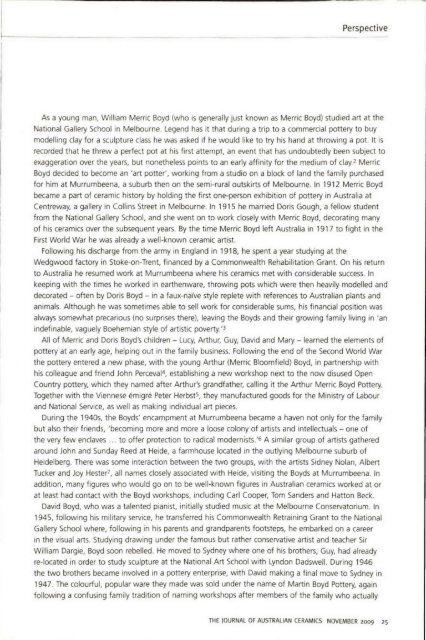The Journal of Australian Ceramics Vol 48 No 3 November 2009
Create successful ePaper yourself
Turn your PDF publications into a flip-book with our unique Google optimized e-Paper software.
Perspective<br />
As a young man, William Merric Boyd (who is generally just known as Merric Boyd) studied art at the<br />
National Gallery School in Melbourne. Legend has it that during a trip to a commercial pottery to buy<br />
modelling clay for a sculpture class he was asked if he would like to try his hand at throwing a pot. It is<br />
recorded that he threw a perfect pot at his first attempt, an event that has undoubtedly been subject to<br />
exaggeration over the years, but nonetheless points to an early affinity for the medium <strong>of</strong> clay.2 Merric<br />
Boyd decided to become an 'art potter', working from a studio on a block <strong>of</strong> land the family purchased<br />
for him at Murrumbeena, a suburb then on the semi-rural outskirts <strong>of</strong> Melbourne. In 1912 Merric Boyd<br />
became a part <strong>of</strong> ceramic history by holding the first one-person exhibition <strong>of</strong> pottery in Australia at<br />
Centreway, a gallery in Collins Street in Melbourne. In 1915 he married Doris Gough, a fellow student<br />
from the National Gallery School, and she went on to work closely with Merric Boyd, decorating many<br />
<strong>of</strong> his ceramics over the subsequent years. By the time Merric Boyd left Australia in 1917 to fight in the<br />
First World War he was already a well-known ceramic artist.<br />
Following his discharge from the army in England in 1918, he spent a year studying at the<br />
Wedgwood factory in Stoke-on-Trent, financed by a Commonwealth Rehabilitation Grant. On his return<br />
to Australia he resumed work at Murrumbeena where his ceramics met with considerable success. In<br />
keeping with the times he worked in earthenware, throwing pots which were then heavily modelled and<br />
decorated - <strong>of</strong>ten by Doris Boyd - in a faux-na'ive style replete with references to <strong>Australian</strong> plants and<br />
animals. Although he was sometimes able to sell work for considerable sums, his financial position was<br />
always somewhat precarious (no surprises there), leaving the Boyds and their growing family living in 'an<br />
indefinable, vaguely Boehemian style <strong>of</strong> artistic poverty. '3<br />
All <strong>of</strong> Merric and Doris Boyd 's children - Lucy, Arthur, Guy, David and Mary - learned the elements <strong>of</strong><br />
pottery at an early age, helping out in the family business. Following the end <strong>of</strong> the Second World War<br />
the pottery entered a new phase, with the young Arthur (Merric Bloomfield) Boyd, in partnership with<br />
his colleague and friend John Perceva l', establishing a new workshop next to the now disused Open<br />
Country pottery, which they named after Arthur's grandfather, calling it the Arthur Merric Boyd Pottery.<br />
Together with the Viennese emigre Peter Herbst S , they manufactured goods for the Ministry <strong>of</strong> Labour<br />
and National Service, as well as making individual art pieces.<br />
During the 1940s, the Boyds' encampment at Murrumbeena became a haven not only for the family<br />
but also their friends, 'becoming more and more a loose colony <strong>of</strong> artists and intellectuals - one <strong>of</strong><br />
the very few enclaves ... to <strong>of</strong>fer protection to radical modernists.'6 A similar group <strong>of</strong> artists gathered<br />
around John and Sunday Reed at Heide, a farmhouse located in the outlying Melbourne suburb <strong>of</strong><br />
Heidelberg. <strong>The</strong>re was some interaction between the two groups, with the artists Sidney <strong>No</strong>lan, Albert<br />
Tucker and Joy Hester 7 , all names closely associated with Heide, visiting the Boyds at Murrumbeena. In<br />
addition, many figures who would go on to be well-known figures in <strong>Australian</strong> ceramics worked at or<br />
at least had contact with the Boyd workshops, including Carl Cooper, Tom Sanders and Hatton Beck.<br />
David Boyd, who was a talented pianist, initially studied music at the Melbourne Conservatorium. In<br />
1945, following his military service, he transferred his Commonwealth Retraining Grant to the National<br />
Gallery School where, following in his parents and grandparents footsteps, he embarked on a career<br />
in the visual arts. Studying drawing under the famous but rather conservative artist and teacher Sir<br />
William Dargie, Boyd soon rebelled. He moved to Sydney where one <strong>of</strong> his brothers, Guy, had already<br />
re-Iocated in order to study sculpture at the National Art School with Lyndon Dadswell. During 1946<br />
the two brothers became involved in a pottery enterprise, with David making a final move to Sydney in<br />
1947. <strong>The</strong> colourful, popular ware they made was sold under the name <strong>of</strong> Martin Boyd Pottery, again<br />
following a confusing family tradition <strong>of</strong> naming workshops after members <strong>of</strong> the family who actually<br />
THE JOURNAL OF AUSTRALIAN CERAMICS NOVEMBER <strong>2009</strong> 25


















